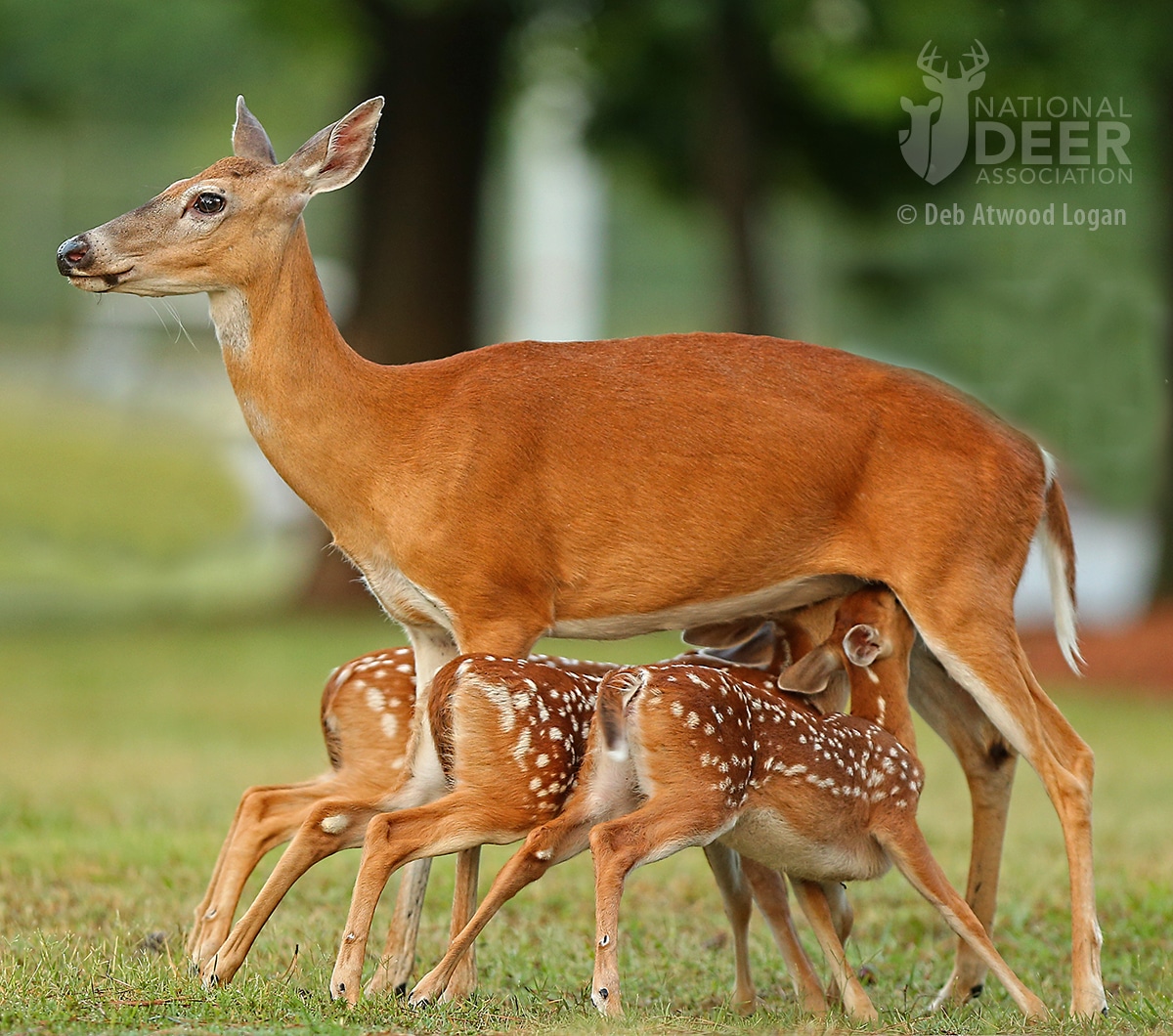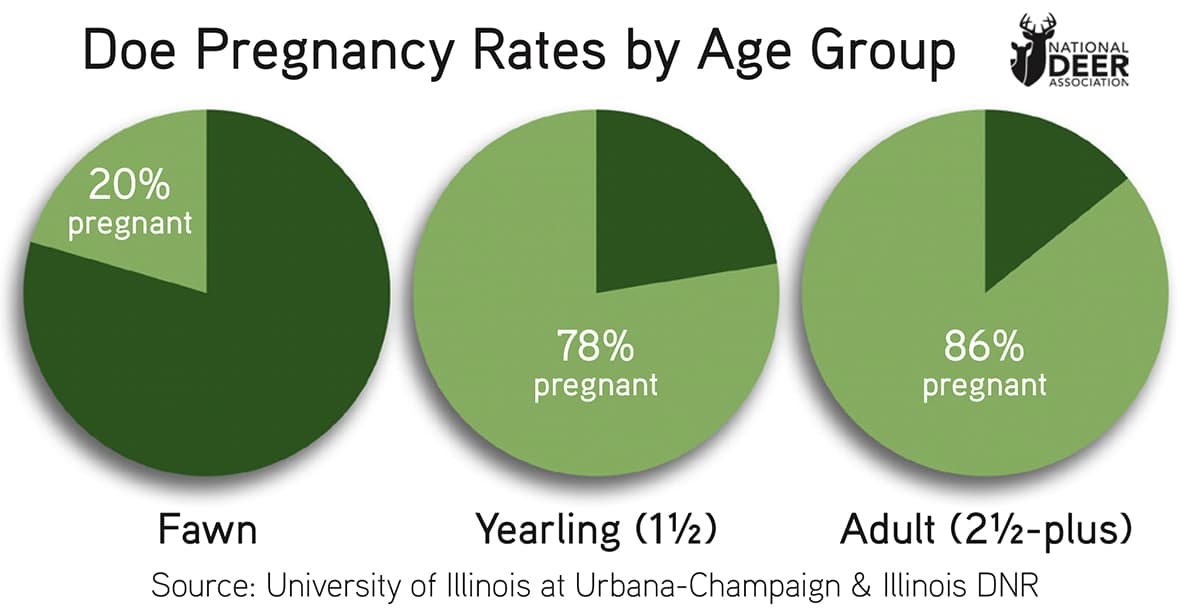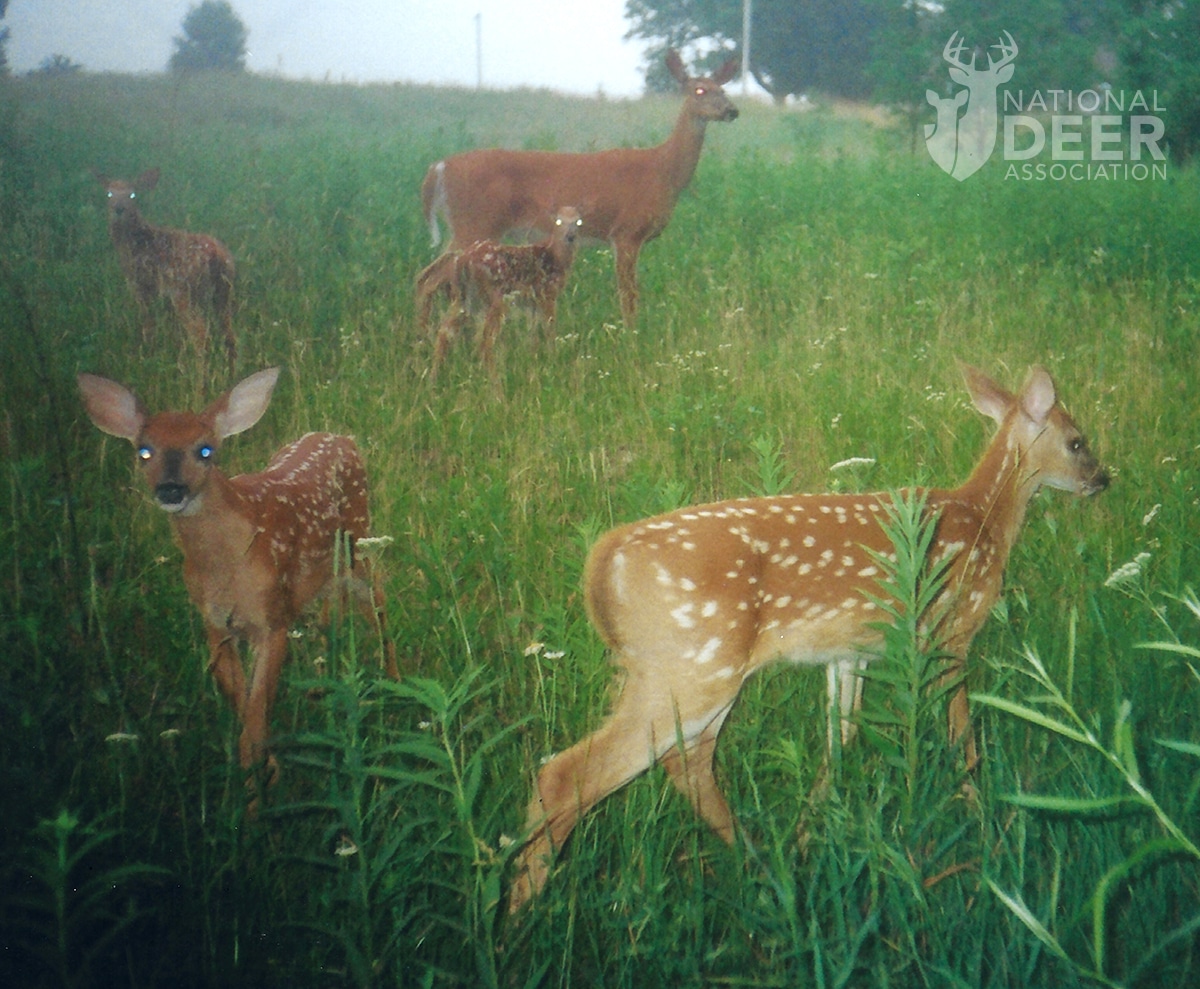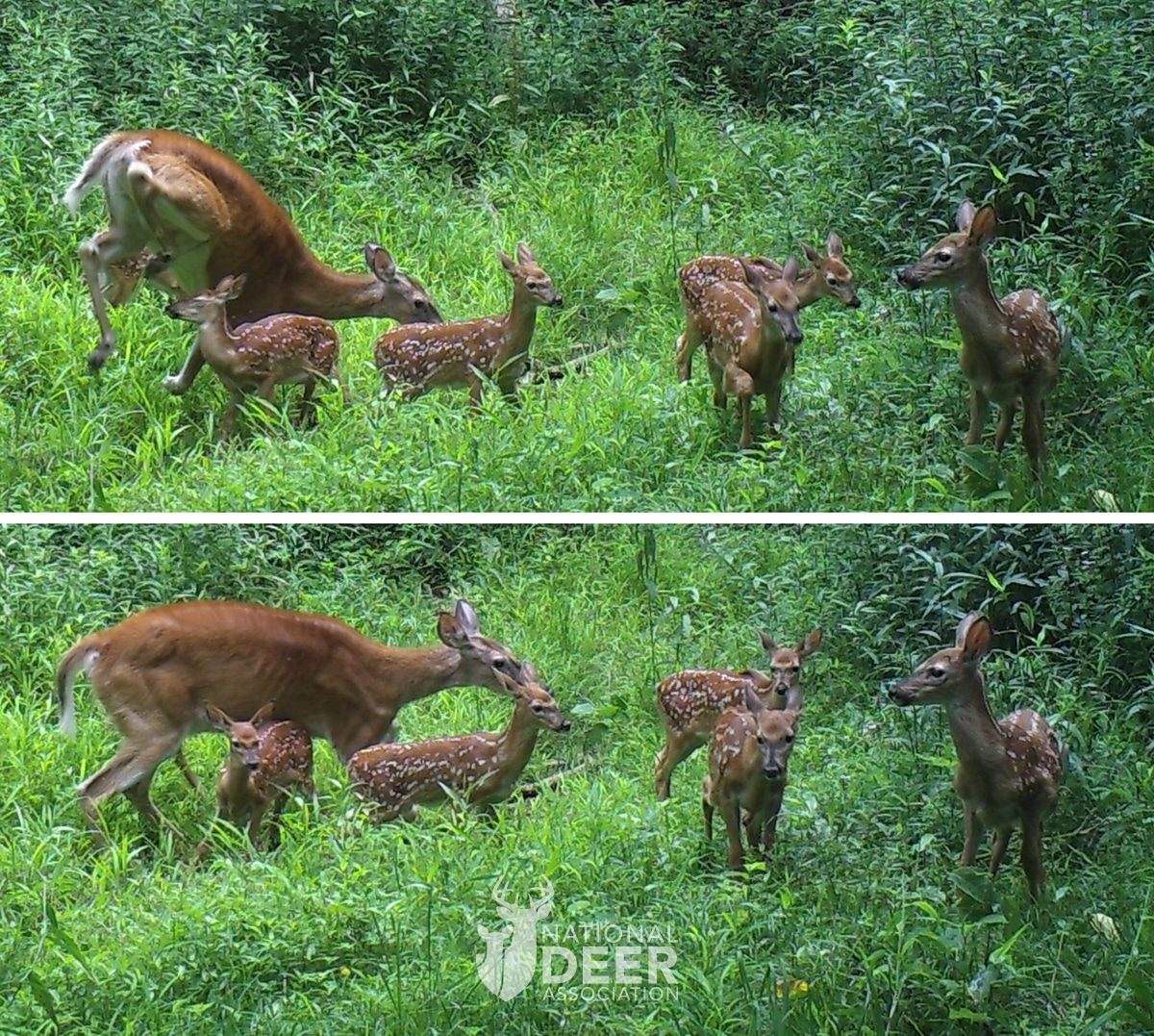
A whitetail doe can give birth to one, two or three fawns each year, and that’s the limit for almost all of them. A very rare doe will bear quadruplet fawns. And rarest among the rare, making Boone & Crockett bucks look commonplace, are the documented cases of quintuplet whitetail pregnancies – five fawns. Here, in one bundle, is a look at the rules of whitetail reproduction and those who break them.
Whitetail pregnancy rates and the number of fawns per pregnancy are strongly related to doe age and herd health. Single births are more common among younger does in their first-ever pregnancy. Most healthy, adult whitetail does give birth to twins. In lower-quality habitat or areas where deer density is too high, twins are about as good as it gets. In higher-quality habitat where deer numbers are in balance with available nutrition, as many as 15% of adult does may bear triplets. Yes, fewer does in quality habitat actually recruit more fawns than overpopulated does in poor habitat.
How often do these healthiest of healthy whitetails give birth to quadruplet fawns? Are quintuplet fawns even possible? Here’s what I learned in my search for the most fertile wild does ever documented.
Illinois Quadruplet and Quintuplet Fawns
One of the biggest-ever studies of wild doe fertility took place in northern Illinois from 2003 to 2013. Each winter after hunting season, Illinois DNR removed small numbers of deer from numerous chronic wasting disease management zones across 15 counties as part of a targeted removal effort to hold CWD prevalence rates low. Researchers with the University of Illinois at Urbana-Champaign (UIUC) examined the deer. Deer that tested negative for CWD were processed for donation to local food banks.
Over those 11 years, researchers examined 3,884 does that did not have CWD – 65% of them, or 2,543, were pregnant. If that pregnancy rate seems low, this figure includes doe fawns under 1 year of age. For fawns in the study, 20% were pregnant, while 78% of 1½-year-olds (yearlings) and 86% of adults were pregnant.

Of these 2,543 pregnant does…
- 533 of them were carrying a single fawn (21%)
- 1,796 of them were carrying twins (71%)
- 201 of them were carrying triplets (8%)
- 12 of them were carrying quadruplets (0.47%)
- 1 of them was carrying quintuplets (.04%)
These pregnancy rates and the average fawns-per-doe by age class showed these deer are in the upper range of health among previously studied populations around the whitetail’s range. Not the highest ever recorded, but higher than average. It’s northern Illinois, just south of the Wisconsin border, a highly productive area of the Midwest for whitetails. So, 8% of pregnant does bearing triplets is a good number and only to be expected in high-quality habitat.
As seen in other studies, doe age played a role in litter size. See the chart below for a visual. Most pregnant doe fawns carried only one fetus, and one of them was carrying triplets. Of the 12 instances of a doe with quadruplets, three of them were yearlings and nine were adults. The only case of a doe with quintuplets – yes, five fawns – was an adult.
This doe represented .05% of the 2,543 pregnant does. If you count the does that weren’t pregnant, she represented .025% of all the does in the sample. Literally a quintuplet rate of one in almost 4,000 existing does.

Quintuplet Fawns in Wisconsin
That Illinois quintuplet case was not the first documented set of five. In January 2006, a Wisconsin farmer shot a doe using an agricultural damage permit, and it was carrying five fetuses. The farmer notified Wisconsin DNR, and a biologist collected the deer for study. Dr. Tim Van Deelen of the University of Wisconsin-Madison reported the quintuplets included four bucks and one doe. One of the bucks weighed significantly less than its siblings, but otherwise the fetuses were normal.
Amazingly, the doe carrying these quintuplets was 1½ years old based on tooth replacement patterns, which indicates yearlings with almost 100% accuracy, so this age estimate is likely dead on. For any doe to carry quintuplets is rare, but it’s especially unusual that this doe was only a yearling since litter size is strongly related to doe age.
At the time of Tim’s report, he could not find another documented case of quintuplet whitetails in the scientific literature, making his report the first. He noted two reports from outside scientific publications – in New Jersey and Michigan – of quintuplet fetuses.
This is only the pregnancy rate. A quintuplet pregnancy does not guarantee the birth of five, living, healthy fawns. If they are all live born, then the real survival challenge begins. The odds of each of those five fawns surviving their first two weeks can be less than half in many areas. The reality check arrives in the form of coyotes, bobcats, black bears, thunderstorms and other weather exposure, disease, and even abandonment or malnutrition. So, the odds of all five fawns surviving to recruitment age are far lower than one in 4,000.
I found no documented cases of quintuplet live births, much less survival of all five fawns for any length of time. However, there’s a little more evidence available for live births of quadruplet fawns, and even brief survival.

Illinois DNR Tags Quadruplets
Google “quadruplet fawns” and you’ll find a few videos of does nursing four fawns, most of them in suburban settings. Because a doe is nursing four fawns does not mean they are all hers, but it’s very likely.
The strongest documentation of quadruplets I found is by Charlie Nixon, a wildlife ecologist with the Illinois Natural History Survey, now retired. In his 1993 account from Illinois DNR’s Outdoor Illinois Journal, Charlie was searching for newborn fawns to tag as part of a DNR survey when he saw a doe with a newborn fawn. When he approached, he saw not one but four newborn fawns lying together at the birth site. He said he was able to carefully handle and ear-tag all four – two males and two females – without alarming or scattering them. This was May 17.
“All four fawns were seen with their mother in late June, and all appeared none the worse for the tagging experience,” wrote Charlie. “One fawn was killed, probably by a predator—likely a fox or coyote—in early July. The remaining fawns survived to the hunting season in October.”
Even in this well-documented case, all four quadruplets did not make it to recruitment age, though 75% of them making it almost two months is a very good survival rate for the early weeks. Though I could not find documented evidence for living quintuplet fawns, I believe it has happened. There are millions of whitetail does in North America, and they’ve been here for millions of years. It’s a matter of math.
Eyewitness Encounters May Not Be Reliable
If you see a doe with three, four or even five fawns tagging along, does that mean you saw a sibling set? Not necessarily. In general, the earlier you see fawns with a single doe, the more likely they are related. Young, spotted fawns being nursed by the same doe are very likely all hers. Whitetail does are territorial loners when they give birth and while they are raising very young fawns. They don’t tolerate the presence of other deer. And the likelihood of a wild doe nursing a fawn that isn’t hers, though not impossible, is probably very low.

By fall, however, does and fawns move back in with larger social groups of other does and fawns. Odds get much lower that you can match does and fawns just because they are traveling together. A study by Penn State and the Pennsylvania Game Commission found that barely half of the fawns captured in baited drop nets or rocket nets were the offspring of the does they were captured with. Trapping, however, took place in winter after hunting season, when fawns were approaching a year of age, and when hunter-harvest likely had rearranged the makeup of most groups of antlerless deer.
The Final Frequency?
So, how often do whitetails give birth to triplets or more? I believe the multi-year Illinois study gives us the most realistic ballpark estimate for all does examined, not just those that were pregnant. In a productive herd in a region of the Midwest with high-quality habitat:
- 5.2% of all does were pregnant with triplets, or 1 in 19 does.
- 0.3% of all does were pregnant with quadruplets, or 1 in 324 does.
- 0.026% of all does were pregnant with quintuplets, or 1 in 3,884 does.
You can expect these litter sizes to be more rare in most of the whitetail’s range, especially areas like the Northeast and Deep South with less productive habitat. They’ll be more rare even in the Midwest in areas where deer density is too high for the habitat quality. But they might occur more frequently than this in areas with exceptional habitat, great soils, and proactive herd management by hunters.
Whitetails are prey animals. With good health and ample nutrition, they are more than capable of compensating for losses to predation and hunter harvest. In fact, in many areas today, they are overcompensating. To ensure continued good health and sustainable populations, deer hunters should remain active and engaged managers of deer density where they hunt.
CWD and Deer Fertility
Recall the Illinois study only reported data for CWD-negative does. However, they also examined CWD-positive does, and they continue to do so as the study continues. I asked Dr. Nohra Mateus-Pinilla, study supervisor and a veterinary epidemiologist at UIUC, if fertility rates were lower for CWD-positive does. She said they are seeing little difference.
“Becoming pregnant isn’t the issue for a CWD-positive doe,” she said. “The issue is the ability to raise a fawn to survive by itself. And that doe will most likely be transmitting CWD to her fawn. That’s the impact of CWD, in my opinion. The doe’s ability to take those fawns to recruitment age.”












